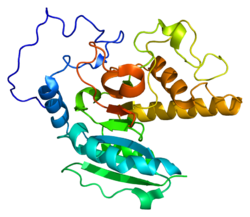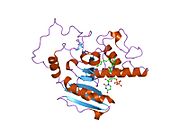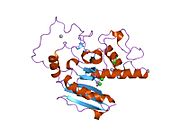An allele, or allelomorph, is a variant of the sequence of nucleotides at a particular location, or locus, on a DNA molecule.

In genetics, dominance is the phenomenon of one variant (allele) of a gene on a chromosome masking or overriding the effect of a different variant of the same gene on the other copy of the chromosome. The first variant is termed dominant and the second is called recessive. This state of having two different variants of the same gene on each chromosome is originally caused by a mutation in one of the genes, either new or inherited. The terms autosomal dominant or autosomal recessive are used to describe gene variants on non-sex chromosomes (autosomes) and their associated traits, while those on sex chromosomes (allosomes) are termed X-linked dominant, X-linked recessive or Y-linked; these have an inheritance and presentation pattern that depends on the sex of both the parent and the child. Since there is only one copy of the Y chromosome, Y-linked traits cannot be dominant or recessive. Additionally, there are other forms of dominance, such as incomplete dominance, in which a gene variant has a partial effect compared to when it is present on both chromosomes, and co-dominance, in which different variants on each chromosome both show their associated traits.

In biochemistry, a transferase is any one of a class of enzymes that catalyse the transfer of specific functional groups from one molecule to another. They are involved in hundreds of different biochemical pathways throughout biology, and are integral to some of life's most important processes.

The ABO blood group system is used to denote the presence of one, both, or neither of the A and B antigens on erythrocytes. For human blood transfusions, it is the most important of the 44 different blood type classification systems currently recognized by the International Society of Blood Transfusions (ISBT) as of December 2022. A mismatch in this serotype can cause a potentially fatal adverse reaction after a transfusion, or an unwanted immune response to an organ transplant. Such mismatches are rare in modern medicine. The associated anti-A and anti-B antibodies are usually IgM antibodies, produced in the first years of life by sensitization to environmental substances such as food, bacteria, and viruses.

Glycosyltransferases are enzymes that establish natural glycosidic linkages. They catalyze the transfer of saccharide moieties from an activated nucleotide sugar to a nucleophilic glycosyl acceptor molecule, the nucleophile of which can be oxygen- carbon-, nitrogen-, or sulfur-based.
The Kell antigen system is a human blood group system, that is, a group of antigens on the human red blood cell surface which are important determinants of blood type and are targets for autoimmune or alloimmune diseases which destroy red blood cells. The Kell antigens are K, k, Kpa, Kpb, Jsa and Jsb. The Kell antigens are peptides found within the Kell protein, a 93-kilodalton transmembrane zinc-dependent endopeptidase which is responsible for cleaving endothelin-3.

Beta-hexosaminidase subunit beta is an enzyme that in humans is encoded by the HEXB gene.
The Lewis antigen system is a human blood group system. It is based upon two genes on chromosome 19: FUT3, or Lewis gene; and FUT2, or Secretor gene. Both genes are expressed in glandular epithelia. FUT2 has a dominant allele which codes for an enzyme and a recessive allele which does not produce a functional enzyme. Similarly, FUT3 has a functional dominant allele (Le) and a non-functional recessive allele (le).

Hexosaminidase A (alpha polypeptide), also known as HEXA, is an enzyme that in humans is encoded by the HEXA gene, located on the 15th chromosome.
In enzymology, a polypeptide N-acetylgalactosaminyltransferase is an enzyme that catalyzes the chemical reaction
In enzymology, a glycoprotein-fucosylgalactoside alpha-N-acetylgalactosaminyltransferase is an enzyme that catalyzes the chemical reaction

Galactoside 3(4)-L-fucosyltransferase is an enzyme that, in humans, is encoded by the FUT3 gene.

Polypeptide N-acetylgalactosaminyltransferase 3 is an enzyme that in humans is encoded by the GALNT3 gene.

Mucin-7 is a protein that in humans is encoded by the MUC7 gene. In animals, the MUC7 gene is found in most placental mammals, but not marsupials.

Polypeptide N-acetylgalactosaminyltransferase 1 is an enzyme that in humans is encoded by the GALNT1 gene.

N-acetyllactosaminide beta-1,6-N-acetylglucosaminyl-transferase is an enzyme that in humans is encoded by the GCNT2 gene.

Polypeptide N-acetylgalactosaminyltransferase 2 is an enzyme that in humans is encoded by the GALNT2 gene.

Beta-1,4 N-acetylgalactosaminyltransferase 1 is an enzyme that in humans is encoded by the B4GALNT1 gene.

Beta-1,4 N-acetylgalactosaminyltransferase 2 is an enzyme that in humans is encoded by the B4GALNT2 gene.
Cis AB is a type of rare mutation in the ABO gene. It happens when the transferase allele contains a mix of amino acids from either A or B alleles, producing a bifunctional enzyme that can produce both types of antigens, usually with one weaker than the other. This results in a serum test result much like the standard, separate (trans) AB phenotype, although the weaker antigen can occasionally fail to be detected. It complicates the basic inheritance pattern and blood-transfusion compatibility matching for ABO blood typing.
























































